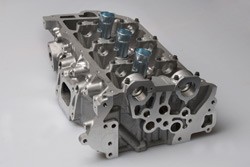2012 Chevrolet Camaro engine weight savings – Click above to watch the video after the jump

Instead, engineers were able to add extra power by allowing the high-tech mill to breathe better. To do this, intake airflow was improved by seven percent through extensive simulation and bench testing. As a result, power is up by 11 horsepower, while exhaust flow is improved by 10 percent.
Engineers also manged to remove an incredible 13 pounds from the 3.6-liter by integrating the exhaust manifolds into the aluminum cylinder head. This change meant that a pair of old-school iron manifolds, 12 bolts, a pair of gasket and heat shields with six more bolts were eliminated.
Beyond weight savings, these changes also eliminate the potential for gasket failure while fuel efficiency is improved. The 2012 Camaro 2LS model will now boast 30 miles per gallon on the highway, up from an also respectable 29 mpg from the 2011 model.
Hit the jump to watch a short video, which shows exactly how GM was able to shave 13 pounds off of an already reasonably light engine. Then you can stay to read over The General's press release.
The video meant to be presented here is no longer available. Sorry for the inconvenience.
In auto production, more power, better fuel economy and fewer emissions rarely appear together. But the 2012 Camaro 3.6L direct injection V6 engine achieves all three by combining the exhaust manifold with the cylinder head into a single aluminum casting.
Each integrated exhaust manifold cylinder head – a V6 has two -- replaces a cast iron exhaust manifold, six bolts, a gasket and a heat shield and three bolts. By eliminating this joint, the potential for a gasket failure is eliminated. And the change reduces engine weight by 13 lbs. or 6 kg per engine. Reducing mass helps improve fuel economy and the 2012 Camaro 2LS model is EPA estimated at 30 mpg highway.
"Reducing engine mass of this magnitude doesn't happen often," said Ameer Haider, GM assistant chief engineer for V6 engines. "Engineering usually looks for reduction in terms of grams not pounds. It's just like removing a set of golf clubs from your car when you don't need them – ultimately it saves fuel. When combined with other mass reductions, the customer will see better fuel economy over time with better performance."
Extensive simulation and bench testing was performed to perfect cylinder-head airflow. Intake airflow is improved 7 percent with the use of larger intake valves (38.3 mm v. 36.9 mm), which are primarily responsible for an increase of 11 horsepower. Exhaust flow is 10 percent better than the previous V6.
Lower emissions, narrower engine size and noise reduction round out the list of benefits for the new head design. With the catalytic converter closer to the engine exhaust point, the emissions reduction process begins sooner, resulting in lower emissions. The new cylinder heads decrease the overall width of the engine by 4.6 inches (117 mm) for significantly more packaging space in the engine bay making underhood work easier. Due to less surface area, the new design contributes to a 1 decibel reduction in engine noise at idle.
"The new, patented design benefits the customer in all the key areas without any tradeoffs, said Haider. "Emissions, performance, fuel economy, and noise all improve with the integrated exhaust manifold."
Each integrated exhaust manifold cylinder head – a V6 has two -- replaces a cast iron exhaust manifold, six bolts, a gasket and a heat shield and three bolts. By eliminating this joint, the potential for a gasket failure is eliminated. And the change reduces engine weight by 13 lbs. or 6 kg per engine. Reducing mass helps improve fuel economy and the 2012 Camaro 2LS model is EPA estimated at 30 mpg highway.
"Reducing engine mass of this magnitude doesn't happen often," said Ameer Haider, GM assistant chief engineer for V6 engines. "Engineering usually looks for reduction in terms of grams not pounds. It's just like removing a set of golf clubs from your car when you don't need them – ultimately it saves fuel. When combined with other mass reductions, the customer will see better fuel economy over time with better performance."
Extensive simulation and bench testing was performed to perfect cylinder-head airflow. Intake airflow is improved 7 percent with the use of larger intake valves (38.3 mm v. 36.9 mm), which are primarily responsible for an increase of 11 horsepower. Exhaust flow is 10 percent better than the previous V6.
Lower emissions, narrower engine size and noise reduction round out the list of benefits for the new head design. With the catalytic converter closer to the engine exhaust point, the emissions reduction process begins sooner, resulting in lower emissions. The new cylinder heads decrease the overall width of the engine by 4.6 inches (117 mm) for significantly more packaging space in the engine bay making underhood work easier. Due to less surface area, the new design contributes to a 1 decibel reduction in engine noise at idle.
"The new, patented design benefits the customer in all the key areas without any tradeoffs, said Haider. "Emissions, performance, fuel economy, and noise all improve with the integrated exhaust manifold."





Sign in to post
Please sign in to leave a comment.
Continue